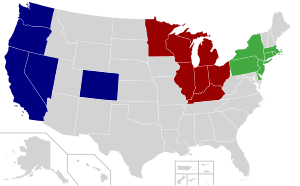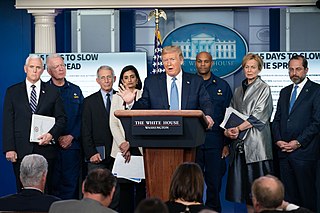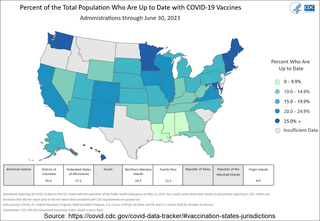Parties

| State | Governor | Accession |
|---|---|---|
| Gavin Newsom | April 13, 2020 | |
| Jared Polis | April 27, 2020 | |
| Steve Sisolak | April 27, 2020 | |
| Kate Brown | April 13, 2020 | |
| Jay Inslee | April 13, 2020 | |
| Sources: [15] [16] | ||
The Western States Pact is an interstate compact between five western states in the United States to coordinate the rollback of economic restrictions implemented by the state governments in response to the COVID-19 pandemic.
In announcing the Western States Pact on April 13, 2020, California, Oregon and Washington governors Gavin Newsom, Kate Brown, and Jay Inslee jointly announced that "COVID-19 doesn’t follow state or national boundaries. It will take every level of government, working together, and a full picture of what’s happening on the ground." [1]
The agreement was made with four goals:
On April 27, Colorado governor Jared Polis and Nevada governor Steve Sisolak announced their states would join the Western States Pact, with the latter noting the importance of information sharing. [3]
On April 30, 2020, research and education networks from the states involved, such as the University Corporation for Atmospheric Research's Front Range GigaPop, Nevada System of Higher Education's NevadaNet, CENIC, Link Oregon, and the Pacific Northwest Gigapop, announced they would be joining the shared approach under the Western States Pact and would be offering ultra-broadband research and education telecommunications networks and services to support the Western States Pact. [4]
On May 11, the Western States Pact released a letter, signed by the governors and state legislative leaders of all five states, to Congress requesting $1 trillion in aid to help deal with the financial effects of the coronavirus. The letter states that the aid would "preserve core government services like public health, public safety, public education and help people get back to work. It would help our states and cities come out of this crisis stronger and more resilient." [5] [6]
On September 16, the governors of California, Oregon, and Washington announced a joint pilot project to test the COVID-19 Exposure Notification System developed by Apple and Google for mobile phones. If the pilot project is successful, these states would then plan to roll out the technology to all residents. Since Colorado and Nevada already have statewide Exposure Notification apps, all states in the Western States Pact would then be participants in the system. [7] [8]
On October 27, the governors of Nevada, Oregon, and Washington announced that their states would join California's COVID-19 Scientific Safety Review Workgroup. This workgroup would provide the Western States Pact with a coordinated review of any potential COVID-19 vaccine, independent of the federal Food and Drug Administration (FDA). [9]
On November 13, California, Oregon, and Washington issued a joint travel advisory, encouraging residents to avoid non-essential travel and urging people arriving from other states to self-quarantine for 14 days. [10] [11]
On December 14, the Western States Scientific Safety Review Workgroup analyzed safety and efficacy data for the Pfizer-BioNTech COVID-19 vaccine. The workgroup unanimously recommended authorization of the vaccine for emergency use, allowing California, Nevada, Oregon, and Washington to proceed with vaccination campaigns without delay. [12] On December 20, the workgroup also recommended authorization of the Moderna COVID-19 vaccine. [13]
On March 3, 2021, the Western States Scientific Safety Review Workgroup recommended authorization of the Janssen COVID-19 vaccine. [14]

| State | Governor | Accession |
|---|---|---|
| Gavin Newsom | April 13, 2020 | |
| Jared Polis | April 27, 2020 | |
| Steve Sisolak | April 27, 2020 | |
| Kate Brown | April 13, 2020 | |
| Jay Inslee | April 13, 2020 | |
| Sources: [15] [16] | ||
Shortly after the Western States Pact and northeastern states announced their own joint plans on April 13, 2020, U.S. president Donald Trump asserted his "total authority" over the states' decisions about when to lift the shutdowns implemented in response to the pandemic. [17] After criticism from both Democratic and Republican members of Congress, Trump clarified on April 14 that he would be "authorizing each individual governor of each individual state to implement a reopening" of their economy. However, Cornell Law School professor Kathleen Bergin said, "Trump has no authority [...] These are matters for states to decide under [...] the Tenth Amendment to the Constitution." [18]
After Hawaiian business leaders and state House Speaker Scott Saiki encouraged joining the Western States Pact, governor David Ige said he considered joining the pact but decided not to because Hawaii did not share a land boundary with the member states of the pact. [19]

Gavin Christopher Newsom is an American politician and businessman serving since 2019 as the 40th governor of California. A member of the Democratic Party, he was the 49th lieutenant governor of California from 2011 to 2019 and the 42nd mayor of San Francisco from 2004 to 2011.
The following is a list of notable events, births and deaths from 2020 in the United States.

In the United States, the worldwide pandemic of coronavirus disease 2019 (COVID-19) caused by severe acute respiratory syndrome coronavirus 2 (SARS-CoV-2) has resulted in 103,436,829 confirmed cases with 1,174,676 all-time deaths, the most of any country, and the 20th-highest per capita worldwide. The COVID-19 pandemic ranks first on the list of disasters in the United States by death toll; it was the third-leading cause of death in the U.S. in 2020, behind heart disease and cancer. From 2019 to 2020, U.S. life expectancy dropped by 3 years for Hispanic and Latino Americans, 2.9 years for African Americans, and 1.2 years for white Americans. These effects persisted as U.S. deaths due to COVID-19 in 2021 exceeded those in 2020, and life expectancy continued to fall from 2020 to 2021.
The first confirmed case relating to the COVID-19 pandemic in the United States was announced by the state of Washington on January 21, 2020. Washington made the first announcement of a death from the disease in the U.S. on February 29 and later announced that two deaths there on February 26 were also due to COVID-19. Until mid-March, Washington had the highest absolute number of confirmed cases and the highest number per capita of any state in the country, until it was surpassed by New York state on April 10, 2020. Many of the deceased were residents of a nursing home in Kirkland, an Eastside suburb of Seattle in King County.

The COVID-19 pandemic in California began earlier than in some other parts of the United States. Ten of the first 20 confirmed COVID-19 infections in the United States were detected in California, and the first infection was confirmed on January 26, 2020. All of the early confirmed cases were persons who had recently travelled to China, as testing was restricted to this group, but there were some other people infected by that point. A state of emergency was declared in the state on March 4, 2020. A mandatory statewide stay-at-home order was issued on March 19, 2020; it was ended on January 25, 2021. On April 6, 2021, the state announced plans to fully reopen the economy by June 15, 2021.

The COVID-19 pandemic reached Colorado on March 5, 2020, when the state's first two cases were confirmed. Many of the early COVID-19 cases in Colorado occurred in mountain resort towns such as Crested Butte, Aspen, and Vail, apparently brought in, and sometimes taken home, by international ski tourists.
The COVID-19 pandemic was confirmed to have reached the U.S. state of Nevada on March 5, 2020. Because of concerns about coronavirus disease 2019 (COVID-19), Nevada governor Steve Sisolak declared a state of emergency on March 12, 2020. Four days later, Nevada reported its first death. On March 17, 2020, Sisolak ordered the closure of non-essential businesses in the state, to help prevent the spread of the coronavirus. Grocery stores were among the businesses considered essential, and restaurants were allowed to provide drive-thru, takeout, and delivery services. At the end of March 2020, Sisolak announced a 90-day moratorium on evictions and foreclosures for commercial and residential tenants. The moratorium would be extended several times over the next year.
This article outlines United States-related events which occurred in the year 2021.
The following is a timeline of the COVID-19 pandemic in the United States during 2020.

The Donald Trump administration communicated in various ways during the COVID-19 pandemic in the United States, including via social media, interviews, and press conferences with the White House Coronavirus Task Force. Opinion polling conducted in mid-April 2020 indicated that less than half of Americans trusted health information provided by Trump and that they were more inclined to trust local government officials, state government officials, the Centers for Disease Control and Prevention (CDC), and National Institute of Allergy and Infectious Diseases director Anthony Fauci.

Operation Warp Speed (OWS) was a public–private partnership initiated by the United States government to facilitate and accelerate the development, manufacturing, and distribution of COVID-19 vaccines, therapeutics, and diagnostics. The first news report of Operation Warp Speed was on April 29, 2020, and the program was officially announced on May 15, 2020. It was headed by Moncef Slaoui from May 2020 to January 2021 and by David A. Kessler from January to February 2021. At the end of February 2021, Operation Warp Speed was transferred into the responsibilities of the White House COVID-19 Response Team.

Beginning in early April 2020, there were protests in several U.S. states against government-imposed lockdowns in response to the COVID-19 pandemic in the United States. The protests, mostly organized by conservative groups and individuals, decried the economic and social impact of stay-at-home orders, business closures, and restricted personal movement and association, and demanded that their respective states be "re-opened" for normal business and personal activity.

The wearing of non-medical face masks in public to lessen the transmission of COVID-19 in the United States was first recommended by the CDC on April 3, 2020, as supplemental to hygiene and appropriate social distancing. Throughout the pandemic, various states, counties, and municipalities have issued health orders requiring the wearing of non-medical face coverings — such as cloth masks — in spaces and businesses accessible to the public, especially when physical distancing is not possible.

The federal government of the United States initially responded to the COVID-19 pandemic in the country with various declarations of emergency, some of which led to travel and entry restrictions and the formation of the White House Coronavirus Task Force. As the pandemic progressed in the U.S. and globally, the U.S. government began issuing recommendations regarding the response by state and local governments, as well as social distancing measures and workplace hazard controls. State governments played a primary role in adopting policies to address the pandemic. Following the closure of most businesses throughout a number of U.S. states, President Donald Trump announced the mobilization of the National Guard in the most affected areas.
Freedom Angels Foundation is an anti-vaccination group in California. Initially constituted in an attempt to counter the state's new vaccination laws in 2019, the group is playing a major role in protests against the public measures enacted in relation to the COVID-19 pandemic, joining far-right groups in the protests against lockdowns and the defeat of Donald Trump in 2020.
The Eastern States Multi-state Council is an interstate compact between seven northeastern states in the United States to coordinate the rollback of economic restrictions implemented by the state governments in response to the COVID-19 pandemic.
The Midwest Governors Regional Pact is an interstate compact between seven midwestern states in the United States to coordinate the rollback of economic restrictions implemented by the state governments in response to the COVID-19 pandemic.

The COVID-19 vaccination campaign in the United States is an ongoing mass immunization campaign for the COVID-19 pandemic in the United States. The Food and Drug Administration (FDA) first granted emergency use authorization to the Pfizer–BioNTech vaccine on December 10, 2020, and mass vaccinations began four days later. The Moderna vaccine was granted emergency use authorization on December 17, 2020, and the Janssen vaccine was granted emergency use authorization on February 27, 2021. By April 19, 2021, all U.S. states had opened vaccine eligibility to residents aged 16 and over. On May 10, 2021, the FDA approved the Pfizer-BioNTech vaccine for adolescents aged 12 to 15. On August 23, 2021, the FDA granted full approval to the Pfizer–BioNTech vaccine for individuals aged 16 and over.
The government of California initially responded to the COVID-19 pandemic in the state with a statewide lockdown, the first of its kind during the COVID-19 pandemic in the United States. As the pandemic progressed in California and throughout the rest of the country, the California government, following recommendations issued by the U.S. government regarding state and local government responses, began imposing social distancing measures and workplace hazard controls.

The United States' response to the COVID-19 pandemic with consists of various measures by the medical community; the federal, state, and local governments; the military; and the private sector. The public response has been highly polarized, with partisan divides being observed and a number of concurrent protests and unrest complicating the response.